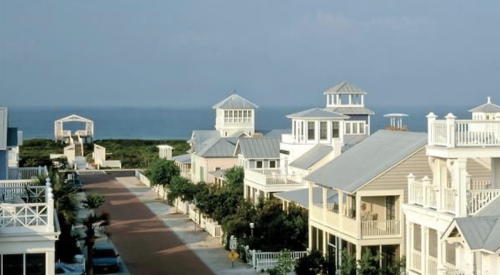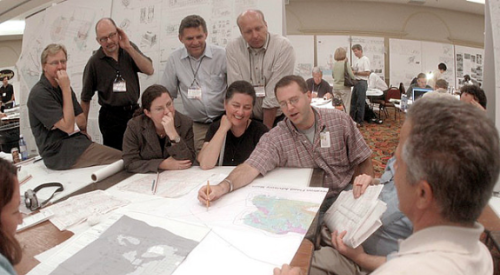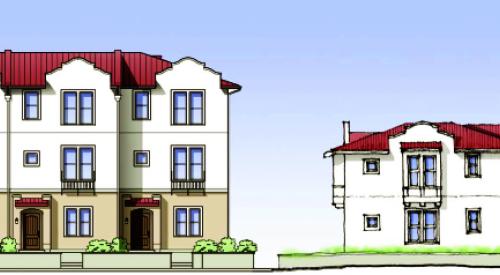Miami-based architect and town planner Andres Duany, 50, tired of fighting for approval of his neotraditional development plans one by one, is now working directly with municipalities, in various parts of the country, to establish development ordinances that place Traditional Neighborhood Design on an equal footing with conventional suburban development. By doing so, he hopes to allow TNDs a chance to reach their full potential as a component of the American housing market.
Duany believes that between 30% and 60% of new home buyers will eventually choose to live in compact, pedestrian-friendly (mixed-use and of-ten rear-loaded) TND hamlets, villages, and towns, rather than in conventional suburban sub-divisions.
Born in New York City, Duany grew up in Cuba, in a prominent family of Cuban residential developers. He left the island at age 10 in the turmoil of the Cuban revolution. He met his wife, Elizabeth Plater-Zyberk at Princeton University in the late 1960s. Both went on to graduate school at Yale, where they studied under architectural historian Vincent Scully. From 1976 to 1980, they designed condos at an architectural firm in Miami.
Andres Duany believes Traditional Neighborhood Design is the planning model of the future as well as the past.
Their rejection of conventional suburbia came after listening to a series of talks by European urban theorist Leon Krier. Teaming with idealistic Florida developer Robert S. Davis, Duany and Plater-Zyberk decided to tour small towns and hamlets across the South. The trio gradually developed a portfolio of design principles that led to development of Seaside, their landmark 1981 re-sort development in the Florida panhandle that has become Mecca to the TND movement.
Today, there are about 150 neotraditional communities in various stages of development across North America, over 30 of them designed by the architectural and planning firm Duany Plater-Zyberk. Most of them look a lot more like the 1920s communities than those built in Post WW II America. Plater-Zyberk is now also dean of the University of Miami's School of Architecture.
Duany and Plater-Zyberk recently collaborated with Jeff Speck to author their first book, Suburban Nation: The Rise of Sprawl and the Decline of the American Dream, published last month.
PROFESSIONAL BUILDER: Traditional Neighborhood Design is becoming a very hot item. Atlanta builder John Wieland recently estimated that it's now 35% of the Raleigh market and growing, and becoming the preferred form of development in Charlotte and elsewhere across the South, all of this apparently driven by planning departments and elected officials who have suddenly become TND evangelists. What's going on?
ANDRES DUANY: The increasing opposition to growth and development is the vice that drives it. In most cases, it's not by code. But TND is perceived by many people, in and out of government, to be part of the solution rather than part of the problem. What's happening is that many of the civil servants want so badly to do a TND that they're twisting developers' arms in that direction, even though TND is not required by code. The planners just tell them, very subjectively, that if they do a TND, they'll make life easy. If they don't, they'll make life hard.
How do the builders and developers feel about that?
Many of them don't like it at all. For instance, I was up in Charlotte, doing a project, and I heard about two developers who were being forced to do a TND, and they were pissed off about it. So we met with them, and heard what they had to say. We went through it for 45 minutes, and I can tell you that nothing was a problem, except in their heads or in the planners' heads.
There are so many misconceptions and anxieties about TND, from different sources, some of them fabricated by professionals who have a vested interest in the existing system.
What kind of misconceptions?
All the things you can't do. We are not telling people what they can't do. We want people to be able to do what they want. We are trying to facilitate that. For instance, these developers were being told that they had to do a grid (street plan). DPZ hasn't done a pure grid in years. It doesn't have to be a grid; it just has to connect! It needs to be a network (of streets).
That's the misunderstanding. When we develop TND ordinances, we allow for discontinuities wherever there are topographical or ecological conditions that make it necessary.
One of Duany's favorite TND communities is Haile Plantation in Gainesville, Fla.
In this case, the problems arose from bad TND ordinances in Charlotte. Very draconian. But people become fanatics. That's why we got into writing TND ordinances. If you want to have a cul-de-sac that's a mile long, you should be able to do it, as long as it's justified. You should be able to ex-plain that there's a ridge there that makes it necessary, and then it's perfectly fine.
We try to eliminate such things, because they cause traffic congestion, but where they are necessary, we write mitigating language into the ordinance to allow solutions that make sense.
What's necessary to get good TND ordinances enacted by local governments?
First, we have to explain very, very thoroughly what conventional suburbia is, where it came from, and the kinds of problems it causes. We have to make the participants in the public process experts. That's very important, because if you don't educate them, they dumb everything down to traffic counts. You can't make them go away, so you have to make them experts.
We show them why conventional suburbia causes traffic jams and increases taxes. Then we show that TND is an entirely different proposition that causes substantially less damage.
You sell TND as a lesser of two evils?
Well, you can never say that TND doesn't in-crease traffic. Any new development will have more traffic than an empty cornfield. You have to convince people that growth is coming, no matter what. Unless they vote in a Stalinist government. Stalin was the last guy able to shuffle people around to where he wanted them and keep them away from where he didn't want them. In a free market, you can't stop them. They will only stop coming when you ruin the place.
Haile Plantation was designed not by DPZ, but by its developer, Bob Kramer. It's an example of TND that works by adapting the design principles to fit the project.
The next step is to convince them that TND impacts less. Not nothing, but less. Then the third step is to show them a positive impact, as a tradeoff against the negative. Many people will prefer that empty cornfield, but we show them something positive to offset the loss of the corn-field. A village is an even trade. A subdivision, like all the others, is not an even trade. But a really neat village will be seen by many people to be better than a cornfield.
Can you really convince people who op-pose growth to change their minds?
It's not hard to show people that there are places in this world that are worthier than an open field. No one wants to destroy Charleston to re-store the open wetlands. Few people are going to want to displace the beautiful little Main Streets we have in rural villages all over this country. That's what we do. Show them that the work of man can be of equal or greater value than an open field.
What do you do when you run into some-one who doesn't buy your argument?
You have to respect that those people are still responding rationally. Builders and developers need to understand that nobody is out to get them. People only know what they've experienced over the last 50 years. In virtually every case where development has happened, they've had to make a downward trade. In any transaction, you gain something and you lose something. If you constantly come out on the short end, you stop trading. That's what many communities are doing. They'd rather have a potato field.
Now, saying the trade should be even and proving that it can be are two different things. I now spend 90% of my time demonstrating that. Right now, many of the people able to influence the decision on a project think "the builders are only in it for profit," as if that were intrinsically bad.
But absolutely everything ever done in this country was done for profit. All of the places we love were built for profit, every town and village. Almost every house! We have to make clear again that builders and developers are capable of creating places we can love. It's the suburban development model that's at fault, not the profit motive.
What's the biggest mistake builders make today?
Assuming that the people are stupid. The dumbing down process astounds me. Retailers do it too. As soon as you get to the people who must sell a product to the public, they think the people are too stupid to understand. It's not the developers. I have yet to meet a dumb developer. They are generalists. They have to know a lot about everything to be successful. There are more dumb attorneys and dumb doctors than dumb developers. Builders will say, "I understand, but my buyer doesn't." They always slide the blame to the people. But if that's true, it's because builders have trained buyers to think that way.
How have builders trained buyers to think erroneously?
People are trained by their experiences in shopping for homes. Builders have trained them to look for gimmicks, like plant shelves, double-height vaulted spaces, curved staircases. None of these things make a real difference in their lives. Yet builders don't trust them to think that living in a neighborhood where their children can walk to a park is important. It has become so difficult to sell exterior architecture, when the street scene is a sea of garage doors, that builders have become experts at selling interior architecture.
There's no question that, dollar for dollar, American builders deliver the best private realm in the world. Houses here are articulated beautifully. What you get for $250,000 in North Dallas is absolutely breathtaking. You can visit the most affluent countries in the world and nothing com-pares. But we are delivering the best private realm only because we must compensate for the public realm, which is the most brutal in the world. You can't find anything like it in the Old World.
As soon as you leave your cul-de-sac, the very first collector road is brutal. The only way to sur-vive it is to cocoon yourself inside a mobile private realm, which is what a car is.
How is TND so different from that?
It creates a public realm that is benevolent, streets and public spaces that people can love. And those streets are saleable. One of the good things about this is that builders can calm down the interior architecture and get back to selling neighborhood and streetscape instead of gimmicks. I look at houses for sale today, and I see they have theaters and sidewalk cafes built right into them. Why? Because the people who buy those houses know they can't walk to a sidewalk café in the public realm. There's no corner café, so the builder tries to internalize that space into the house. Why do we need living rooms that are like plazas? Because when we walk out the door, it's no good.
In a good TND, the individual home can be smaller and simpler, yet still sell for a higher price and margin, because the neighborhood is so good. Ask any Realtor how they sell existing homes. Neighborhood first, house second.
Many builders say TND is harder to sell, because there's a 15% premium for anything with alleys over a conventional cul-de-sac house and lot, and today's TND alleys are too tight for the big SUVs people now drive…
The premium doesn't have to be that high. I know because I've made all the mistakes that create the price differential. It gets very technical. On the tight alleys, one aspect of it is how much land you actually sell, rather than making the alley wider. In a lot of projects, the alleys are too tight because the builders think selling a 110-foot deep lot sounds better to the buyers.
In Disney's Celebration, for example, the price premium is not all in the public realm. The architectural standards are probably higher than they need to be. If David Weekley were allowed to just do his thing, without meeting the extreme Celebration code for materials and construction methods, the premium would be less. It wouldn't be any less a TND, the architecture just wouldn't be as good as Disney dictates.
Do you really believe TND neighborhoods are so much better that they can be sold as an amenity?
Absolutely. Builders and developers have no trouble selling a golf course as an amenity that increases the value of every house and lot in the community. A TND neighborhood is no different. Actually, it's less expensive. But a walkable town with a retail and commercial core is the same kind of amenity. Look at the investment equation. A golf course is $6 million and 180 acres. A town center is $2 million and 16 acres. I've always thought that a Main Street is a better deal.
And you don't need an entry feature. There's no collector street. No driveways. TND has to cost the same, or it's not going to really take off the way it should. A lot of people have made a lot of mistakes, including us. But at least we now know where to fight the battles. Many of the mistakes you fall into are made by working with conventional suburban standards.
Like what?
When you allow parking on the street, in front of houses, the post office says it won't deliver the mail, because they want to use their little jeeps. So the builder decides to put the mail boxes in the alley. No, says the post office, because their de-livery people can't deal with the fact that there are two streets represented in the alley, rather than one. It's ridiculous.
In that case, we solved the problem by reading the postal regulations, which say that if you re-quest foot delivery, you get it. Kentlands did it. Now the delivery people in the post office are fighting over those routes. Why? Because they get exercise. They are well known by their customers. They get invited to community functions. And every Christmas, they go home with Christmas gifts that are way better than anything the people in the jeeps get.
Once you get into it, the entire system falls into place. But you can't apply suburban model standards to TNDs. When you do, it's like trying to run a Macintosh program on a DOS operating system. I now spend 90% of my time writing the interface between the two development models.
So you don't want to eliminate conventional subdivisions, just make the approval process even between TND and conventional?
The proposition we make when we do a regional plan is that we have to leave suburbia in place. There are people who love suburbia. But those who do not love it are not being provided an alternative. Somewhere between 30% and 60% want suburbia, but another 30% to 60%, whatever the proportion becomes, want TND and should be given a level playing field. We design an operating system that plugs in and makes it as easy to do a TND as to do a regular subdivision. That's what I told the developers in Charlotte. They should not have an ordinance that dictates TND; they should have both. But it's also unfair to have conventional ordinances and require TND developers to do every-thing on variances. It's a free market. The market should decide.
Where are you doing such model ordinances?
We are writing a model TND code right now that will be national, but we're doing it specifically for Hillsborough County, Fla., which includes Tampa, for Columbus, Ohio, and for Onondaga County, N.Y.
If TND becomes the equal of conventional suburban development, there's going to be a lot of work for architects, designing new house plans for rear-loaded communities. What are the keys to good product for a TND?
It's not so tough. In Florida, Don Evans is doing it. I just visited some of his houses. Moving the garage to the back of the lot unleashes a whole series of ideas designers have never had before. Right now, every possible permutation of floor planning has been done. All you get are variations. But this dislodges whole new ways of looking at the equation. Some of our architects are very skillful. I've heard that Don Evans is really enjoying doing TND.
In North Dallas, they've had alley-loaded houses for years, but they stupidly attach the garages to the back of the house. They whack them up against the house to save a few bucks, then spend way more to put seven gables on the front elevation. They should re-allocate the budget for the gables to do a proper back building, with a home office or granny flat above a garage.
Do all TND houses have to look like the ones we've seen so far, which are mostly narrow, deep houses to fit narrow, deep lots?
No. I've taken a typical North Dallas floor plan and done a declension that produces exactly the same square footage on the same size lot, and the best way to go is actually wide and shallow. It's an 80-foot deep lot. You get a fantastic back yard. What you have to give up is all that space in the front yard, which is useless anyway. Suburban houses have deep setbacks only because the garage is on the front of the house.
Personally, I live on a 50 X 100-foot lot, with the house set back five feet. The house is raised a little. The public rooms are on the front of the house, private spaces to the rear. My back yard is absolutely, totally private. And it's huge. Anybody who says TND rear yards are too small is not doing them right. The garage can be located to block all neighbors' views into that yard. I have a relationship with my neighbors that's very com-forting, but it comes from the front of the house.
That's great, but you live in Miami. How do you deal with snow plow issues in northern TNDs?
It's true that sometimes the cities up north seem to think that snow plow drivers are totally unskilled, but have you ever watched them clear a supermarket parking lot? They don't need big rights-of-way to get the plow through. We don't underestimate people. We count on human ingenuity. And an alley is much easier to plow than all those driveways out front in suburbia. You just leave a dumping ground at one end. This is another trade-off. Would you rather shovel your driveway or have a plow go down the alley?
Are there variations in alley design like those you describe in house plans?
There are two choices. Back alleys, which are for high-density urban applications, where you pave from garage door to garage door. And rear lanes, which are designed for the almost- rural edges of a TND. They can be irregular and meander back and forth. Like a piece of the country behind the homes. That becomes a principal playground for children. Our best clients really get into this. I always get into trouble with engineers when I start talking about these issues. Take drainage. If I were designing roads, I'd want to make sure there are lots of puddles when it rains. When I was a kid, the most fun I ever had was playing in puddles. What do we do? We design perfect drainage, so five minutes after a rain, it's dry. There are no more puddles. That's supposed to be a perfect world?
Over-engineering of suburban roads and cul-de-sacs has been a problem for years…
I'm tired of training engineers over and over. You don't need as much asphalt if you use a little brain power. We now have an engineering firm in-house to do our work.
What do you think the next few years will look like, with all the smart growth initiatives popping up across the country?
I certainly think TND will be a growing part of it. There's a market for housing aimed at smart people. I think, for one thing, that baby boomers are not as easy to manipulate as previous generations. I don't know anyone my age who would ever buy into an age-restricted retirement community. It may be baby boomers who drive what-ever success TND achieves.











